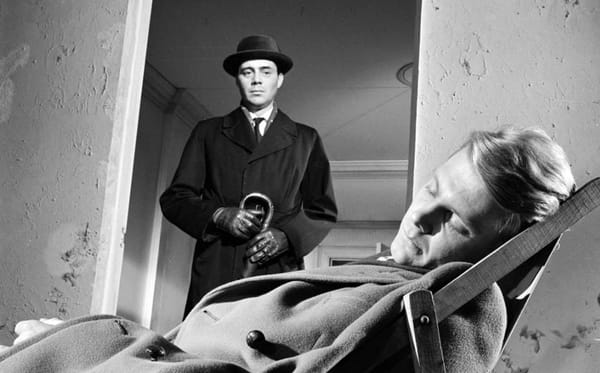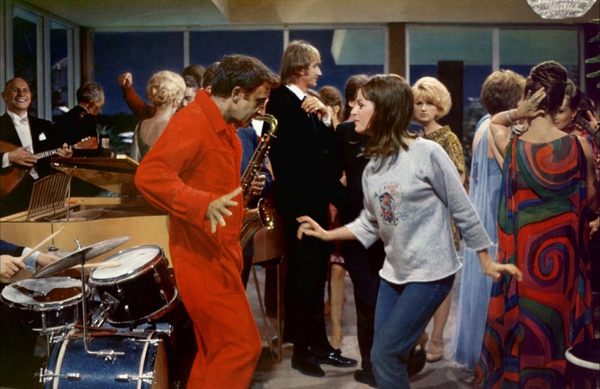Somewhere on the Outside

On Devil in a Blue Dress and American pop culture's ever-evolving "tragic mulatta"
What might Douglas Sirk have made of Rachel Dolezal? This past year has seen nothing short of a large-scale sociocultural reckoning with the act of racial passing. There were the scandals in the academic world following the unmasking of disgraced activist-professors Jessica Krug, BethAnn McLaughlin, Kelly Kean Sharp, and several others who made strides in their professional fields while posing as Black, Latinx, and other nonwhite identities for years, perhaps consciously following the same path paved most indelibly by Dolezal, arguably the most unapologetic and indefatigable scammer in recent times. Concurrently, Brit Bennett’s engrossing, decades-spanning page-turner The Vanishing Half became a national book club sensation upon its publication, earning a deserved place on the New York Times’ list of the ten best books of 2020. Bennett’s sophomore effort is remarkable for allowing Stella, its steely, light-skinned Black co-protagonist, to successfully live as a white woman in the upper echelons of late twentieth-century American society, without ever concealing the emotional and psychological scars of her deception and the sutured relationship with the abandoned twin sister that such a decision necessitates. In doing so, Bennett distinguishes The Vanishing Half from the ill-fated heroines of predecessors with which it remains in fruitful dialogue, including Nella Larsen’s landmark 1929 canonical novel Passing, which was recently adapted for the big screen by British actor-turned-filmmaker Rebecca Hall and premiered at Sundance in January. Passing’s mesmeric Clare Kendry (played in Hall’s film by Ruth Negga) slinks in and out of the white and Black beaux mondes of 1920s America with spectacular cunning until suffering a tragic death that reinforces what late, biracial Larsen described as the “hazardous business of ‘passing,’ this breaking away from all that was familiar and friendly in order to take one’s chance in another environment, not entirely strange, perhaps, but certainly not friendly.”
As this past year progressed, I found myself returning to two movies, including Sirk’s 1959 masterpiece Imitation of Life, which ends on a note at once tragic and cynically triumphant as white actress Susan Kohner’s beautiful, mixed-race Sarah Jane bum-rushes the funeral of her Black mother (Juanita Moore) to openly repent for renouncing her in order to live fast and loose in the white world. In the final shots, Sarah Jane is integrated, once and seemingly for all, into the family that her mother served since her daughter’s childhood, driving away with Lana Turner and the beautiful white people she always dreamed of being in their chauffeured limousine, away from the scores of Black mourners crowding the street outside the church where her mother’s casket was lain. No matter its direction, passing is where aspiration meets opportunity, a chance to live out one’s desires by discarding the very self who first desired; it feels at once more drastic and honest than the mere bodily imitation endeavored by the endlessly shape-shifting Kardashian and Jenner daughters that has become its own lightning rod. Sarah Jane is the prototypical “tragic mulatta,” that oft-stereotyped figure who maintains a vexed and enduring existence in American popular culture and whose very being straddles the color line between the white and Black worlds of the country that begat her.
Less discussed than Sarah Jane but equally fascinating is Daphne Monet, the effaced femme fatale played with sultriness and sorrow by Jennifer Beals in Carl Franklin’s 1995 neo-noir adaptation of Walter Mosley’s 1990 mystery novel Devil in a Blue Dress. Feminist film scholars like Mary Anne Doane and Molly Haskell have written about how the femme fatale, one of the most contentious archetypes in film noir, directly contradicts the cinematic idea that to see is to know, all while rendering the character into a gaze-seizing object. What, then, are we to make of the representation of the femme fatale as a white-passing "tragic mulatta"? There is a knotty complexity to this portrayal, one that hinges on the irony of a character whose near-constant visibility, like that of the femme fatale, evades knowability, but whose identity as a woman of mixed-race involves an inevitable exposure of her origins and intentions. In cinema specifically, the "tragic mulatta" hides in plain sight, eluding and awaiting the discovery that will result in the breakdown of her facade.
The "tragic mulatta" is given a story but not necessarily a voice in Devil, primarily set in the all-Black enclaves of post-WWII Los Angeles that have seldom been explored or recreated on the big screen with the credible detail and grand scale on display in Franklin’s film. At the center of the story is Ezekiel “Easy” Rawlins (Denzel Washington), a Black war veteran who has recently been laid off from his job as an aircraft machinist and taken up some shady detective work in order to keep up with the mortgage payments on the house he owns in an all-Black suburb. The premise of Devil automatically entails an intervention into the narrative conventions, character types, visual motifs, and recurrent themes of the film noir: if the presence of a sleuth normally arouses displeasure and suspicion among the denizens of the noir landscape, then those feelings are made twofold when the prying investigator is a Black man, especially one who, as in Devil, must slip in and out of the type of predominantly white environs—the Malibu pier, the whites-only wing of the Ambassador Hotel, a home in the Hollywood Hills—where the twin forces of his skin color and inquiring air leave him not merely unwelcome but highly vulnerable to brutality.
The person necessitating Easy’s breaches of these spaces is Beals’ Daphne, a wealthy mayoral candidate’s missing fiancée who is eventually revealed to be Ruby Hanks, a light-skinned Louisiana woman of Black descent on her mother’s side. Although Ruby had been successfully passing for white, the truth of her ancestry has been ferreted out by her fiancé’s competitor, a candidate who happens to be concealing far more nefarious secrets of his own. Daphne’s downfall can be traced back to the mode in which she is casually introduced to both Easy and the viewer — not in the flesh, but in print: standing beside her fiancé in an image splashed across the front page of a newspaper beneath a headline announcing the end of her betrothed’s campaign. The character’s Icarus-like aspiration, then, is not simply to pass, but to pass publicly — as a political wife, a celebrity — in a spotlight that leaves her susceptible to snooping and detection. What she seeks is emancipation and protection from a representative of the very type of governmental power that has left Black Americans alienated and oppressed.
Like Faye Dunaway’s embattled, enigmatic Evelyn Mulwray in Roman Polanski’s classic Chinatown (1974), Daphne/Ruby is the puzzle box of Mosley’s Devil in a Blue Dress: once all the pieces have been fitted together, one is left with the harrowing human proof of white male patriarchy’s long history of sexual aggression and paternal repudiation. The fact that Franklin’s adaptation was pitched to its studio, Columbia TriStar, as a “Black Chinatown” would seem to verify the parallel between Evelyn and Daphne, née Ruby. But such a comparison is only superficial. Unlike Dunaway, who is a far more prominent figure in Chinatown, Beals only occupies a handful of scenes and sequences in Devil, which calls upon the actress to conjure up variations of generalised dread, horror, temptation, and heartache that lack the opportunity for nuance that is afforded Washington and other members of the film’s ensemble. And unlike Evelyn, who is granted agency and self-determination by her authors, Daphne/Ruby is a token in her film, which, as scripted by Franklin, omits the more distressing details of the character’s backstory as outlined in Mosley’s source text — including Ruby’s incestuous, underage relationship with her white father, a queasy revelation that would have certainly strengthened Devil’s connection to Chinatown. Such bowdlerisations turn Daphne/Ruby into little more than a temptress or victim from scene to scene, recycling the salacious poses and breathless pleas of bygone femme fatales like Barbara Stanwyck’s Phyllis Dietrichson in Double Indemnity (1941) and Mary Astor’s Brigid O’Shaughnessy in The Maltese Falcon (1941) though seldom matching their lived, intricate vitality.
In Franklin’s film, we are permitted only glimpses at the emotional and psychological burdens of the "tragic mulatta" and the demonic patriarchy that produced her. Franklin foregoes relating the particulars of Daphne/Ruby’s story to the audience, a decision that flattens and simplifies the character, reducing Daphne to the size of her silent, concluding anguish as she finds herself discarded by the man she loves, even as the threat to their happiness has successfully been eliminated. Only Easy, whose affair with Daphne/Ruby was also scrapped in the page-to-screen transfer, is permitted to hear her story and it is in his voiceover that the scant details of her life are imparted to the viewer: “She had told me her story…like a sinner who wanted to confess. Her name was Ruby Hanks from Lake Charles, Louisiana. And I suppose all she really wanted was a place to fit in.” Excluding Daphne’s history as Ruby may give Devil concision, but it diminishes the morass of racial subversion and psychosexual implication that Mosley expounds on with such frankness in his novel, material totally ripe for a deeper cinematic examination. Its absence not only deprives the "tragic mulatta" of the voice that has long been denied her in American narrative cinema, but strips her of primary ownership over her own story.
Easy triumphs and profits at the end of Devil in a Blue Dress, but it is a compromised victory, one that perpetuates the vile cycle of white male authority and the violence that their supremacy perpetuates. Devil’s final images connote African-American community and a dream of self-sufficient assimilation, explicated by Easy’s decision to be at “the top of the trouble” by going into the P.I. business for himself. But what persists in the mind amid the sunny, suburban tranquility of the film’s ending is the final close-up of Beals’ mute and tear-stained face before Daphne departs Easy’s car and the narrative proper, never to be seen or heard from again. The stricken look on Beals’ face cannot be forgotten; her eyes, which in her first scene crackled with come-hither randiness while coming on to Washington in a hotel room, have been drained of their vitality. Perhaps Daphne is consumed by the past, traumatic experiences that have been recounted to Easy yet are still relegated to the margins of the movie, their potential disclosure once again deemed too problematic or just too thorny for the presumed sensibilities of filmgoers.
Devil in a Blue Dress was released into theaters in September of 1995 and fizzled at the box office, despite critical acclaim and awards, most of them reserved for Tak Fujimoto’s impeccable cinematography and Don Cheadle’s thunderous, star-making turn as Easy’s loose canon sidekick. The decade in which Devil premiered also saw the ascendancy of pop music’s preeminent mixed-race doyenne, Mariah Carey, who has long been persecuted for embracing her Black American roots in song and style. A damning clip from comedian-cum-provocateur Sandra Bernhard’s 1999 TV special Sandra Bernhard: I’m Still Here… Damn It! resurfaced on Twitter last summer and quickly went viral. In it, Bernhard condemns Carey’s post-Tommy Mottola pivot to hip-hop, exclaiming, “Now she’s trying to backtrack on our asses, gettin’ real [N-word]ish up there at the Royalton hotel suite with Puff Daddy and all the greasy, chain-wearing black men,” later instructing her, “Do not try to compete with the fierce ghetto divas… don’t fuck with me, phony white bitch!” Bernhard’s routine attempts something adjacent to passing, appropriating Blackness and muffling Carey’s voice to assert her presumed, gauntlet-throwing authority.
Carey delved deep into her own embattled origins in the strongest passages of her selectively revealing memoir, The Meaning of Mariah Carey, co-written with Michaela Angela Davis and released in September 2020. Carey details her abusive brother’s paranoid accusations that she was passing herself off as white in order to ingratiate herself with the same schoolmates who found new, traumatic ways of humiliating her for being a poor, biracial child of a broken marriage. In one of the most shocking episodes, a group of white girls invite the adolescent Carey to a sleepover in the Hamptons, only to corner her in a garage and bombard her with the n-word. Though often mocked, Carey is recognised as a pioneer in many ways, chief among them for making the “tragic mulatta” a subject rather than an object in her highly personal art, at or near the same moment as a film like Devil continued to flatten her.
The final moments of Devil conjure the lyrics to Carey’s transcendent ballad “Outside,” the closing track of her 1997 album Butterfly, which ends not on a note of uplifting poptimism but one of irreconcilable difference. “Oh, and God knows / That you’re standing on your own / Blind and unguided / Into a world divided,” Carey belts with breathtaking, gospel-backed fortitude in the closing verse. The song’s final lines repeat the boldly despairing chorus, “You’ll always be / Somewhere on the outside,” a destiny that Imitation of Life’s Sarah Jane and The Vanishing Half’s Stella are lucky enough to evade, but one that befalls Devil’s Daphne Monet/Ruby Hanks. Daphne’s desire to pass in a world that never intended for her to thrive, survive, or exist — and her grief when faced with this desire’s impossibility and the reality that her love cannot conquer the colour line — is rendered irreconcilable with the vision of Black American promise and prosperity that ends the film. Instead, Daphne and Ruby simply disappear, leaving only in their wake the as-yet-unfulfilled hope that the "tragic mulatta" may one day be known in all her complexity on the same screen that has made a riddle of her.




